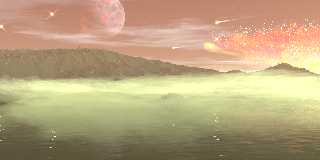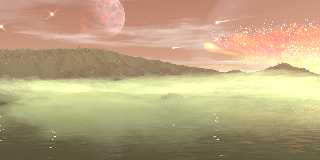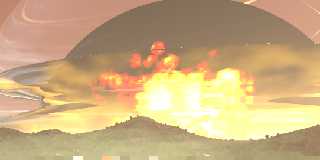 |
 |
|
 |
|
 |
|  |
|  |
|
 |
|
 |
|  |
|  |
|
 |
With the light output of those meteors, shouldn't they be creating diffraction
artifacts in your time machine's camera similar to those of the stars?
Post a reply to this message
|
 |
|  |
|  |
|
 |
|
 |
|  |
|  |
|
 |
On 7-7-2012 4:33, Cousin Ricky wrote:
> With the light output of those meteors, shouldn't they be creating diffraction
> artifacts in your time machine's camera similar to those of the stars?
>
I have been hesitating about that. The answer should be yes, shouldn't
it? I shall add small ones...
Thomas
Post a reply to this message
|
 |
|  |
|  |
|
 |
From: Thomas de Groot
Subject: Re: Early Earth: The Late Heavy Bombardment [final image]
Date: 9 Jul 2012 08:03:53
Message: <4ffac8a9@news.povray.org>
|
|
 |
|  |
|  |
|
 |
This should be the final development of the scene.
Thomas
Post a reply to this message
Attachments:
Download 'earlyearth - lhb_05.png' (835 KB)
Preview of image 'earlyearth - lhb_05.png'

|
 |
|  |
|  |
|
 |
From: Paolo Gibellini
Subject: Re: Early Earth: The Late Heavy Bombardment [final image]
Date: 10 Jul 2012 04:06:08
Message: <4ffbe270$1@news.povray.org>
|
|
 |
|  |
|  |
|
 |
>Thomas de Groot on date 09/07/2012 14.03 wrote:
> This should be the final development of the scene.
>
> Thomas
Ooh.
The explosion is less terrifying (due to the daylight), but the sea and
the fog are very convincing.
;-)
Paolo
Post a reply to this message
|
 |
|  |
|  |
|
 |
From: Thomas de Groot
Subject: Re: Early Earth: The Late Heavy Bombardment [final image]
Date: 10 Jul 2012 07:32:34
Message: <4ffc12d2$1@news.povray.org>
|
|
 |
|  |
|  |
|
 |
On 10-7-2012 10:07, Paolo Gibellini wrote:
> >Thomas de Groot on date 09/07/2012 14.03 wrote:
>> This should be the final development of the scene.
>>
>> Thomas
> Ooh.
> The explosion is less terrifying (due to the daylight), but the sea and
> the fog are very convincing.
> ;-)
Thanks Paolo. I am still terrified though ;-)
I am adding a spherical shock wave to complete the impact.
For the fog over the water I used a df3 file made with Gilles Tran's
MakeCloud.
Thomas
Post a reply to this message
|
 |
|  |
|  |
|
 |
From: Thomas de Groot
Subject: Re: Early Earth: The Late Heavy Bombardment [final image]
Date: 11 Jul 2012 07:32:20
Message: <4ffd6444@news.povray.org>
|
|
 |
|  |
|  |
|
 |
This is really the final image. Added a spherical shock wave.
Thomas
Post a reply to this message
Attachments:
Download 'earlyearth - lhb_final.png' (835 KB)
Preview of image 'earlyearth - lhb_final.png'

|
 |
|  |
|  |
|
 |
From: Alain
Subject: Re: Early Earth: The Late Heavy Bombardment [final image]
Date: 11 Jul 2012 16:30:51
Message: <4ffde27b$1@news.povray.org>
|
|
 |
|  |
|  |
|
 |
> This is really the final image. Added a spherical shock wave.
>
> Thomas
I have some problem with that shock wave: It don't difract light.
A shell with an ior of about 1.1 to 1.17 would be more convincing.
Alain
Post a reply to this message
|
 |
|  |
|  |
|
 |
From: Thomas de Groot
Subject: Re: Early Earth: The Late Heavy Bombardment [final image]
Date: 12 Jul 2012 04:43:33
Message: <4ffe8e35@news.povray.org>
|
|
 |
|  |
|  |
|
 |
On 11-7-2012 22:31, Alain wrote:
> I have some problem with that shock wave: It don't difract light.
> A shell with an ior of about 1.1 to 1.17 would be more convincing.
>
This gets me into problems :-(
For the example I switched off the solid ejecta. I also tuned down the
fog over the water.
For the shock wave I used an ior of 1.01. Obviously, now its media
interacts with the other media inside, especially the dust ejecta
container. Higher ior makes it worse.
Thomas
Post a reply to this message
Attachments:
Download 'earlyearth - lhb.png' (159 KB)
Preview of image 'earlyearth - lhb.png'

|
 |
|  |
|  |
|
 |
From: Alain
Subject: Re: Early Earth: The Late Heavy Bombardment [final image]
Date: 12 Jul 2012 18:49:11
Message: <4fff5467$1@news.povray.org>
|
|
 |
|  |
|  |
|
 |
> On 11-7-2012 22:31, Alain wrote:
>> I have some problem with that shock wave: It don't difract light.
>> A shell with an ior of about 1.1 to 1.17 would be more convincing.
>>
>
> This gets me into problems :-(
>
> For the example I switched off the solid ejecta. I also tuned down the
> fog over the water.
>
> For the shock wave I used an ior of 1.01. Obviously, now its media
> interacts with the other media inside, especially the dust ejecta
> container. Higher ior makes it worse.
>
>
> Thomas
>
It looks like a solid, full, shell. Make the shock wave shell as a
difference of 2 spheres.
To bad we can't have variable ior, as in this case, it should go from 1
(in the air in front of the wave), raise in an S shape to maybe around
1.1, then drop slightly under 1 before returning to 1.
You may also try playing giving the area inside the sinside an ior
slightly less than 1, like 0.98 to 0.995...
Alain
Post a reply to this message
|
 |
|  |
|  |
|
 |
From: Thomas de Groot
Subject: Re: Early Earth: The Late Heavy Bombardment [final image]
Date: 13 Jul 2012 03:45:12
Message: <4fffd208$1@news.povray.org>
|
|
 |
|  |
|  |
|
 |
On 13-7-2012 0:49, Alain wrote:
> It looks like a solid, full, shell. Make the shock wave shell as a
> difference of 2 spheres.
I did too but that was not better, rather worse.
> To bad we can't have variable ior, as in this case, it should go from 1
> (in the air in front of the wave), raise in an S shape to maybe around
> 1.1, then drop slightly under 1 before returning to 1.
Yes, that would be cool.
>
> You may also try playing giving the area inside the sinside an ior
> slightly less than 1, like 0.98 to 0.995...
Yes, I tried too. It corrected somewhat the inner media but did not
change the chock wave appearance.
I shall still make a couple of experiments.
Thomas
Post a reply to this message
|
 |
|  |
|  |
|
 |
|
 |
|  |




![]()